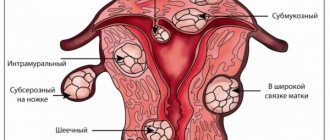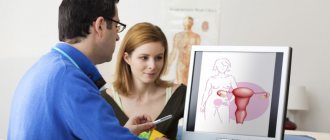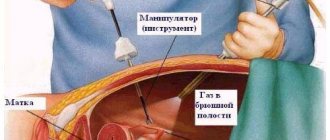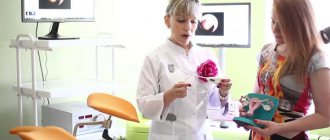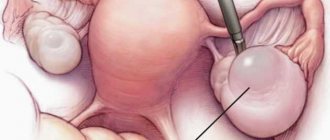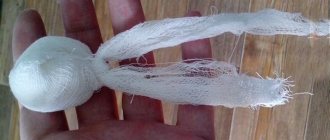After the examination, the woman is given appropriate recommendations for restoring the body. After hysteroscopy, antibacterial therapy is prescribed to exclude infectious complications and the development of endometritis. For the same purpose, sexual abstinence after hysteroscopy is recommended. Thus, a sexual partner can be a carrier of even the most banal pathogens that normally “live” in a woman’s vagina.
WHY AFTER HYSTEROSCOPY THERE ARE NO PERIODS?
Usually, after a diagnostic examination of the uterus and a biopsy, there are no delays in menstruation, since the cycle does not change, and menstruation occurs on time. But some deviations are possible, and a delay in menstruation after hysteroscopy can range from 4 to 15 days, which should not cause concern, since failure of the regularity of critical days after hysteroscopy is not a sign of pregnancy.
Normalization of the menstrual cycle depends on the degree of complexity of the hysteroscopy performed. After surgical hysteroscopy to remove polyps, adhesions or fibroids, the delay may be the length of the menstrual cycle - the day of the operation will be the beginning of menstruation, and the next critical days will arrive on time according to the calendar. If curettage was performed during hysteroscopy, then menstruation may also be delayed, but the delay will not exceed the period of the monthly cycle.
The absence of menstruation after hysteroscopy and the beginning of a new cycle largely depends not only on the degree of complexity of the hysteroscopy performed, but also on the individual characteristics of the female body and its ability to quickly recover. Consultations and observation of a gynecologist
are required.
How long does the postoperative period last and after how long do you go home?
As a rule, the postoperative period when using the hysteroscopy method is shorter than when using abdominal operations on the uterus, including laparoscopic ones. The period during which a woman will need to follow a strict postoperative regimen and stay in the hospital depends on the goals of the procedure:
- If a diagnostic procedure was carried out in the form of an examination of the uterine cavity, the woman can leave the hospital within a few hours. The full recovery period after such an operation lasts no more than 3 days.
- If diagnostic hysteroscopy of a small uterine polyp was performed, which did not require extensive intervention and trauma to the endometrium, the patient may stay in the hospital for a day, sometimes up to three days. The same period of hospital stay is required for the hysteroscopy procedure with endometrial curettage. In this case, the need to monitor the patient’s condition after removal of polyps in the uterus is required for early detection and elimination of bleeding and other possible problems.
- Postoperative care after hysteroscopy for removal of uterine fibroids is the longest. Afterwards, the patient remains in the hospital for at least a week after the operation. The full recovery period can last up to one and a half months.
Types of hysteroscopy of the uterus
Depending on the purpose for which hysteroscopy is performed, it is divided into the following types of hysteroscopy of the uterus:
- diagnostic. During the study, it is possible to determine the degree of enlargement of the uterus, study the condition of the endometrium and identify various pathologies;
- surgical During the examination of the organ, the affected tissue is excised. Such manipulations can be carried out when identifying polyps, endometriosis, fibroids and other diseases of the uterus;
- control. Prescribed after a certain period after the start of therapy. In this way, it is possible to determine the degree of effectiveness of treatment and, if necessary, make adjustments;
- office.
Regardless of the purpose of the study, after it is carried out the body needs time to recover.
How to prepare for hysteroscopy of the uterus with a polyp
Before the procedure, the woman undergoes a gynecological examination, ultrasound and additional instrumental diagnostic methods, which are indicated by the attending physician according to indications.
The woman is assessed for the condition of the uterus, the thickness of its walls, and the presence/absence of additional pathologies. Ultrasound determines the location of polyps, their size and number.
Tests before hysteroscopy of the uterus to remove a polyp can inform about the following:
- The presence of any infection in the vagina (perform a smear);
- Body condition (general blood test);
- State of hormone levels;
- Blood clotting indicators (coagulogram);
- Presence/absence of viral and bacterial diseases (syphilis, hepatitis B and C, AIDS, etc.).
You may need to visit your doctor several times before undergoing the procedure. This is necessary to determine the exact condition of the woman’s uterus, exclude all risk factors and determine the day of manipulation.
A week before hysteroscopy, you should stop using vaginal suppositories, tablets, and douching. Sexual intercourse must be stopped at least three days before hysteroscopy.
If, in agreement with the doctor, general anesthesia will be performed, then food intake should be 6-8 hours before the operation.
NORMAL PROCEDURE
If there were no complications during the procedure, then the period following it is painless. No pathologies arise, no deviations appear. The only thing that gives away the recent procedure is slight bleeding that lasts about 4 days.
If no complications arise, you are allowed to return to sexual activity within a week after the procedure.
Important: In some situations, the doctor may individually prescribe a two-week break. This is not a sign of problems or disorders, but it is imperative to follow the doctor’s instructions and, in order to avoid complications, not to have sex before the allotted time.
Hysteroscopy of the uterus for polyp removal: postoperative period
Reviews about this procedure are mostly positive. The postoperative period after hysteroscopy of the uterus to remove a polyp passes quickly and is rarely accompanied by complications. Most often, the patient can go home on the same day. In some cases, hospitalization for up to 3 days is possible.
After the procedure, at first you may feel pain and cramping in the abdomen, which should go away soon. Bleeding may occur and is considered normal to last up to a week. If they do not go away 7 days after surgery, you should inform your doctor.
A control ultrasound is performed 3-4 days after the procedure. The doctor evaluates the condition of the uterus and endometrium after hysteroscopy.
To eliminate the cause of the pathology and prevent its relapse, hormone therapy is prescribed. It is not indicated for all women and is compiled individually. Treatment may include oral contraceptives, a hormonal intrauterine device, and other hormone-containing drugs.
OPERATING FORM OF THE PROCEDURE
If the procedure was carried out not only for purely diagnostic purposes, then the doctor may decide to perform surgery. In this case, the load on the female body increases, and the risk of negative consequences increases. Even a slight load can lead to unwanted complications. Therefore, the period of abstinence in this case is extended. Its specific duration is determined by the attending physician based on the patient’s individual indications and the characteristics of the procedure.
The average duration of abstinence after surgery ranges from two weeks to about a month.
Complications
Despite the relative safety of the procedure, the possibility of complications cannot be excluded, the conditional classification of which divides them into two types:
- surgical;
- physiological.
Surgical complications include all complications associated with incorrect performance of the procedure due to the unprofessionalism of the doctor or the characteristics of the patient’s body. The list of pathologies resulting from hysteroscopy includes:
- perforation of the wall of the uterus or cervical canal. As a rule, such a complication occurs in cases of resection of the uterine wall using an electroresectoscope or laser, for example, to remove deep-lying fibroids. Treatment after hysteroscopy involves repairing the damage using simultaneous laparoscopy and hysteroscopy;
- intestinal damage as a result of perforation of the muscular layer of the uterus;
- bleeding. Occurs as a result of damage during surgery to a large blood vessel;
- air embolism caused by the penetration of gas bubbles into the bloodstream. As a rule, air enters the uterine cavity through tubes that supply lavage fluid during surgery;
- anesthetic complications. They are a consequence of an allergic reaction to anesthesia.
Important! The use of electro- or laser resection with coagulation minimizes the risk of bleeding due to the ability to “seal” the vascular bed immediately after tissue excision.
All complications of a surgical nature are prevented by careful compliance with all norms and rules for performing the operation.
Postoperative complications of a physiological nature are divided into the following types. Early - inflammatory processes (endometritis, parametritis, adnexitis). Late - deformation of the uterine wall due to the removal of large fibroids, recurrent growth of previously removed tumors and endometriosis. The removed endometrium after surgery can enter the abdominal cavity due to perforation of the uterine wall or through the fallopian tubes.
If the polyp grows again after removal, this may indicate either incomplete removal during surgery or hormonal disorders in the woman’s body. In this case, hormonal drugs are prescribed as treatment. A characteristic feature of the endometrium is its ability to take root on nearby organs, forming endometriosis cysts in the process of growth.
WHY AFTER HYSTEROSCOPY ARE HEAVY MENSURES
Heavy periods after hysteroscopy may occur as a result of unfavorable processes in the uterine cavity; you should especially be wary if the discharge has a strong odor and clots. During surgical hysteroscopy, the uterine mucosa and fallopian tubes may be injured, therefore, in the period after hysteroscopy, special attention should be paid to the condition of the discharge - smell, color, quantity. It must be remembered that you should not self-medicate, since heavy periods can cause large blood loss and a significant decrease in blood pressure, and this can lead to a weakening of the body or loss of consciousness. Therefore, if after hysteroscopy you feel general malaise, you should immediately consult a doctor.
Removal of polyps in the uterus by hysteroscopy: postoperative regimen
Rehabilitation after hysteroscopy of a uterine polyp does not require special measures. A woman needs peace, rest and proper nutrition. In the presence of anemia, which was caused by significant blood loss, the level of hemoglobin in the blood can be corrected with the help of iron supplements or iron-containing foods.
After hysteroscopy, you should abstain from sexual activity and sports for a month. The attending physician will indicate more specific dates, based on the patient’s condition. You should also not visit saunas, steam baths or take long sunbathing under the active summer sun.
To receive a full consultation on performing hysteroscopy in a particular case, you should contact the gynecologists of the Yusupov Hospital. Doctors will prescribe and conduct the necessary examinations, based on which they will formulate the most effective therapy for this patient.
Doctors can help you find out all the nuances of the procedure and the postoperative period that should be expected under given individual circumstances. In the future, you can also undergo preventive examinations here to monitor the condition and exclude relapses. To make an appointment with a specialist at the Yusupov Hospital, just call.
YOU CAN NOT HAVE SEX AFTER HYSTEROSCOPE
After surgical hysteroscopy, the cervix remains open for some time, a wound forms in the uterus, into which an infection can easily be introduced during sex, so the period of sexual abstinence, after examining the patient, is set by the attending physician. If curettage was performed during hysteroscopy, then you cannot have sex for fifteen days. This time is necessary for the restoration of the mucous membrane of the cervix, and if the recommended period of abstinence is ignored, there is a possibility of postoperative infection, which may subsequently become irreversible. In addition to infection, sex after hysteroscopy can cause microtrauma in the vagina, leading to heavy bleeding.
After resuming sexual relations, a woman may feel burning, pain, dryness and other unpleasant sensations in the intimate area. These symptoms are normal and usually go away over time. But if discomfort continues to be felt for a long time, it is necessary to obtain medical advice and further recommendations from a doctor.
Pain syndrome after hysteroscopy
The hysteroscopy method is used by gynecologists to examine the uterine cavity.
The procedure involves inserting a hysteroscope into the uterine cavity to visually examine the condition of the internal surface of the organ. The hysteroscope is equipped with a camera that allows the doctor to obtain the necessary diagnostic data. The procedure is performed under general anesthesia, which ensures painless insertion of the hysteroscope into the uterus.
A disadvantage of the study is the possibility of pain after hysteroscopy.
Hysteroscopy is widely used in clinical practice
Purpose of hysteroscopy
Hysteroscopy does not always have only a diagnostic purpose. The examination is carried out in the following cases:
- The need for minor surgical operations.
- Monitoring the effectiveness of treatment.
- Preparatory period for in vitro fertilization (IVF).
- Diagnosis of uterine diseases.
Causes of pain
Why does my lower abdomen ache after the procedure? How many days does the pain persist? The fact is that before introducing the hysteroscope, the doctor dilates the cervix using special instruments.
This process is quite painful, which is why general anesthesia is used. Before the examination, the organ itself is expanded by introducing liquid or gas. Therefore, after the intervention, the organ contracts, which can also lead to pain.
As a rule, pain after the procedure persists for 3-4 days.
Pain after hysteroscopy in the lower abdomen can be observed for several days
In addition to the contractile activity of the uterus, the cause of pain after hysteroscopy is an inflammatory process.
Inflammation can develop in the uterus or fallopian tubes. In this situation, in addition to pain, vaginal discharge and fever may appear. The discharge most often has an unpleasant odor and an unusual color - yellow, yellowish-gray, brownish with a greenish tint. Body temperature rises to febrile levels - 38-39°C.
If after hysteroscopy the lower abdomen hurts for more than four to five days, you should consult a gynecologist.
The presence of pain for a long time may indicate the occurrence of complications. In the case of diagnostic testing, complications practically do not arise.
However, only a doctor can exclude undesirable consequences after examination and carrying out the necessary tests.
The pain syndrome may be accompanied by bleeding similar to menstruation. This is considered normal if curettage of the uterine mucosa was performed during hysteroscopy. However, spotting can be considered normal for 5-6 days. Longer discharge is also a reason to urgently consult a doctor.
Prevention of complications
In order to prevent possible complications accompanied by pain, it is necessary to properly prepare for the study. Preparation for hysteroscopy includes a number of activities:
- consultation with a therapist and, if necessary, other specialists;
- immediately before the procedure - examination by an anesthesiologist to decide on the method of pain relief;
- ECG;
- if necessary, colposcopy;
- laboratory tests of urine and blood;
- blood clotting control;
- blood chemistry;
- smear for cytology from the cervix;
- study of vaginal microflora.
Since the intervention, in most cases, is performed under general anesthesia, eating is strictly prohibited on the day of the examination.
In addition, bowel preparation is necessary to reduce the risk of developing flatulence on the day of surgery. For this purpose, a special diet is prescribed:
- The diet should be followed for 3-4 days before hysteroscopy.
- The diet should not include foods that increase the production of intestinal gases.
- On the eve of the examination, lunch should be light, and dinner should be avoided completely.
- It is advisable to do a cleansing enema in the evening and morning before the procedure.
- On the day of the test, you should not drink liquids or smoke.
Pain treatment
To reduce pain, the patient may be prescribed analgesics
After the examination, the doctor will prescribe treatment that will eliminate the pain. If there are no signs of inflammation, treatment in this case is symptomatic.
To relieve pain, medications from the group of antispasmodics (No-shpa, Papaverine) and analgesics (Tempalgin, Ketorol, Ibuprofen), or combination drugs are prescribed - Novigan, Nurofen Long, Tempalgin and others.
In cases with the development of the inflammatory process, antibacterial and anti-inflammatory therapy is indicated. Treatment in this case takes a longer time and requires careful medical supervision.
Contraindications to the procedure
The study has contraindications. These include:
- active inflammatory process in the pelvic organs;
- oncological pathology of the cervix;
- pregnancy period (with the exception of a pathological course requiring emergency intervention);
- violation of the blood clotting process;
- severe somatic diseases in the stage of decompensation;
- infectious diseases in the acute period;
- cervical stenosis.
In the above cases, hysteroscopy is not performed, as it may be complicated by adverse consequences.
Source: https://diagnostinfo.ru/skopiya/hysteroscopy/posle-gisteroskopii-bolit-zivot.html
